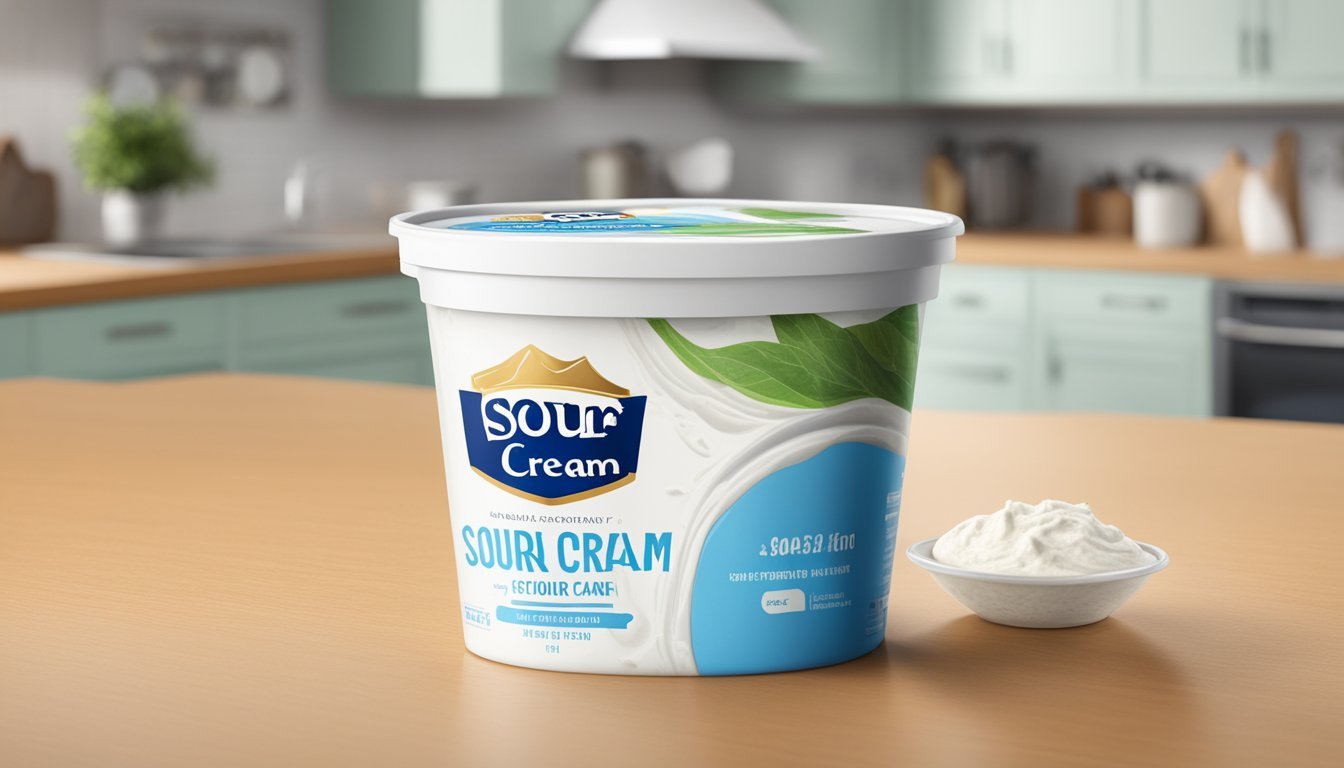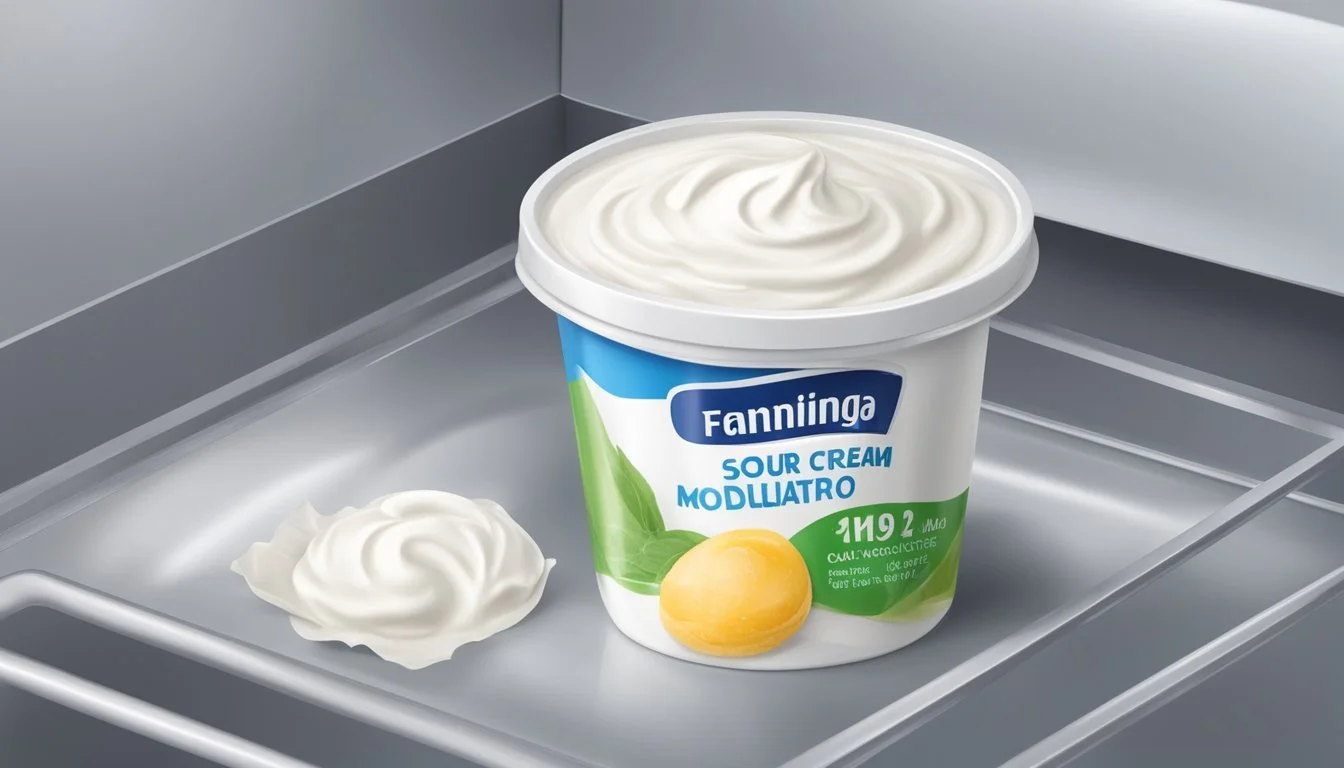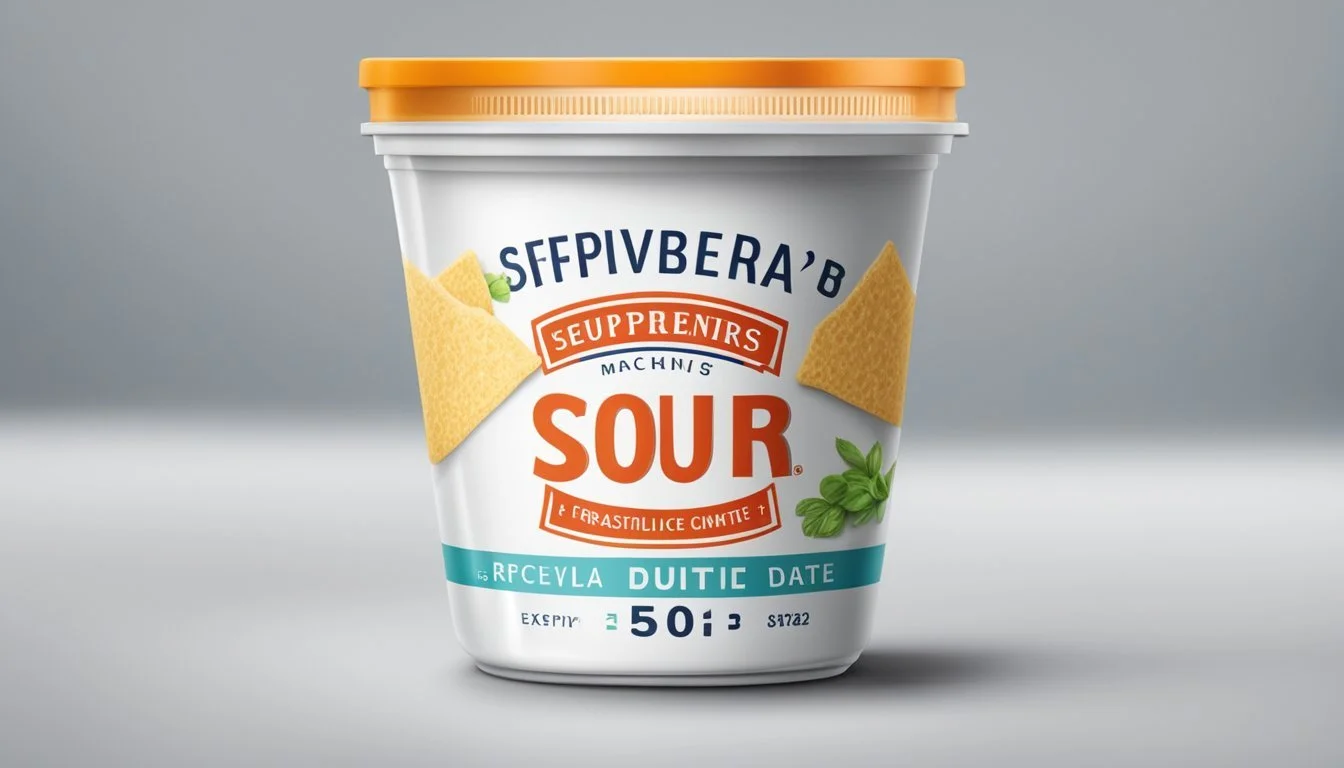Does Sour Cream Go Bad?
Understanding Shelf Life and Spoilage Signs
Sour cream, with its creamy texture and tangy taste, is a staple ingredient in many culinary traditions. Understanding whether sour cream goes bad is crucial, as it affects both the flavor of dishes and food safety concerns. Sour cream is a dairy product that has been fermented with certain types of lactic acid bacteria. The bacteria thickens the cream and gives it the characteristic tart flavor. While the sour nature of this product might make it seem less perishable, sour cream can indeed spoil and become unsuitable for consumption.
Shelf life and spoilage of sour cream depend on a variety of factors including how it is stored, whether it has been opened, and the printed date on the container. Typically, when kept refrigerated, sour cream can remain safe to eat up to three weeks past its sell-by date. The product's integrity hinges on it being stored properly, under constant refrigeration, and in a sealed state to prevent exposure to contaminants. It is vital to recognize the signs of bad sour cream, as consuming spoiled sour cream can lead to foodborne illnesses.
Signs that sour cream has gone bad may include an off smell, mold growth, or a change in texture, such as becoming excessively watery or lumpy. Although a naturally tangy scent is to be expected, a sour cream that has soured further will have an abnormally strong, pungent odor. Consumers need to inspect their sour cream closely before using it in recipes or as a condiment to ensure the best experience and avoid potential health risks.
Understanding Sour Cream
Sour cream, a staple dairy product, is a result of fermenting regular cream with lactic acid-producing bacteria. These bacteria are responsible for thickening the cream as well as giving it the characteristic tart flavor. High fat content in sour cream not only contributes to its creamy texture but also provides a rich taste experience.
The fermentation process involves lactic acid bacteria, such as Lactobacillus, which ferment lactose, the sugars present in cream. This fermentation yields lactic acid, an element that acts as a preservative while also providing the distinctive sour taste.
Nutritional Composition of Sour Cream:
Proteins: Essential for growth and repair
Fats: Contributes to the creaminess; varies from light to full-fat versions
Sugars: Lower content due to fermentation process
Types of Lactic Acid Bacteria Used:
Lactobacillus
Streptococcus
Leuconostoc
Sour cream's shelf life and safety are directly impacted by the effectiveness of these bacteria, along with storage conditions. Properly stored sour cream should remain in good condition for a few weeks beyond its printed date, granted it is kept refrigerated consistently.
In summary, sour cream is a versatile and flavorful dairy product made possible by a dance of microbiology and careful food processing, designed to enrich a wide array of dishes while providing nutritional value. Enjoying sour cream within the proper time frame ensures not only the best taste but also the safety of consumption.
Expiration and Shelf Life
Understanding the lifespan of sour cream is essential to ensure consumption when it is fresh and safe. This section breaks down the significance of product dates and the factors that influence the shelf life of sour cream.
Reading the Dates
Sell-by date: This date informs retailers when to remove the product from shelves, offering a buffer for consumption. Typically, sour cream is safe to consume up to three weeks after the sell-by date if it has been stored properly in the refrigerator.
Use-by date: Often confused with the sell-by date, this date is the manufacturer's last recommended day for peak quality of the product. However, sour cream may still be good past this date if it exhibits no signs of spoilage.
Printed date: Whether a sell-by, use-by, or expiration date, the printed date on the sour cream packaging is provided by the manufacturer and serves as a guideline for freshness.
Factors Affecting Shelf Life
The shelf life of sour cream can be influenced by several factors:
Temperature: Sour cream must be refrigerated at all times to prevent spoilage, ideally at temperatures below 40°F (4°C).
Sealed Packaging: An unopened package of sour cream tends to last longer than an opened one because exposure to air can accelerate the growth of mold and bacteria.
Type of Sour Cream: Full-fat sour cream can last for approximately 2-3 weeks in the refrigerator, whereas reduced-fat sour cream might have a slightly shorter shelf life of 1-2 weeks, and fat-free sour cream around one week.
Users should ensure that the lid provides an airtight seal; if not, transfer the sour cream to an airtight container to extend its usability within the fridge.
Signs of Spoilage
When assessing if sour cream has gone bad, it is important to recognize various signs of spoilage such as visual changes, alterations in texture, and shifts in smell and taste.
Visual Changes
Sour cream that is spoiling may show discoloration, such as a yellowish hue on its surface. This can indicate bacterial growth. In addition, the presence of mold—which may appear in various colors including white, blue, or green—is a clear sign that sour cream should not be consumed.
Changes in Texture
Fresh sour cream has a smooth, creamy consistency. Spoilage is often indicated by a notable change in texture. If the surface appears watery or the sour cream has separated, this suggests it has started to degrade and may be unsafe for consumption.
Smell and Taste Changes
A healthy sour cream has a tangy, but not off-putting smell. Its flavor should match this, being pleasantly sour.
Smell: Spoiled sour cream might emit an off smell or rancid smell. If the product has an unpleasant, sharp, or unusually sour smell, it is likely past its prime and should be discarded.
Taste: Tasting is not recommended, but spoiled products generally have a rancid or off-taste. If sour cream tastes different from its expected tangy flavor, it may indicate spoilage.
Proper Storage Methods
To maintain freshness and extend shelf life, proper storage of sour cream is critical. This involves specific refrigeration techniques and careful handling once the container is opened.
Refrigeration Best Practices
Sour cream must be stored in the refrigerator at a consistent temperature to ensure its longevity and prevent spoilage. The optimal temperature range for storing sour cream is between 34°F and 38°F. Storing sour cream in an airtight container is advised to maintain its quality and guard against contamination. If the original container is not resealable, transferring the sour cream to an airtight container or covering it with plastic wrap can be beneficial.
Handling Opened Containers
Once a container of sour cream is opened, contamination risk increases; therefore, using clean utensils each time it is used is important. Sour cream should be returned to the refrigerator promptly after use. For fresh sour cream, it is best to consume it within 1-2 weeks after opening, regardless of the fat content. Ensuring the lid is sealed tightly or the container is wrapped securely with plastic wrap helps prevent unwanted bacteria from entering and promotes freshness.
Food Safety Considerations
In the context of dairy products, specifically sour cream, food safety is paramount. The primary concerns revolve around the risks posed by spoiled sour cream and the strategies for preventing food contamination.
Risks of Consuming Spoiled Sour Cream
Consuming spoiled sour cream can expose an individual to harmful bacteria, which can lead to food poisoning. The USDA highlights that sour cream should not be used beyond three weeks after the sell-by date. Bacterial growth in spoiled sour cream may manifest as mold, a sour smell, and changes in texture, such as clumping or excessive separation of whey. It's crucial to recognize these signs promptly to mitigate health risks.
Preventing Food Contamination
To prevent food contamination, it is essential to maintain clean handling practices. This includes:
Avoiding Double-Dipping: Using a clean spoon each time to prevent the introduction of unfriendly bacteria from the mouth.
Proper Storage: Keeping sour cream refrigerated at or below 40°F (4°C) consistently to inhibit bacterial growth.
Utensil Cleanliness: Ensuring that serving utensils are clean to prevent cross-contamination.
Sealed Containers: Making sure that containers are airtight; if the original lid is compromised, transfer the sour cream to a clean, airtight container.
By adhering to these guidelines, one can significantly reduce the risk of foodborne illness and extend the shelf-life of sour cream.
Freezing Sour Cream
Freezing sour cream can extend its shelf life, but it also changes its texture and consistency, which is important to consider for its intended use after thawing.
How Freezing Affects Quality
When sour cream is frozen, the water content forms ice crystals, disrupting its creamy texture. Upon thawing, separation can occur, where the whey, the watery part, separates from the solid components. This results in a grainier texture that might not be suitable for all uses, such as topping for baked potatoes or in dips. However, frozen sour cream can still be used effectively in cooked or baked recipes where texture is less critical.
Texture Change: Freezing alters sour cream from creamy to grainy.
Separation: Ice crystals cause whey to separate from the cream upon thawing.
Thawing and Usage
Thawing frozen sour cream should be done gradually in the refrigerator to minimize further texture changes. It's best to stir the thawed sour cream thoroughly to recombine some of the separated components. Keep in mind that although its appearance may change, the taste remains unaffected, making it suitable for recipes where it will be heated and mixed into the dish.
Thaw Gradually: Move the frozen sour cream to the fridge to thaw slowly, typically over several hours or overnight.
Stir Thoroughly: After thawing, stir to reincorporate the whey with the cream.
usage:
Cooked Recipes: Heated recipes are ideal for thawed sour cream.
Baked Goods: The altered texture is less noticeable in baked dishes.
Remember to only freeze sour cream that's fresh and has been stored properly before freezing to ensure the best quality after thawing.
Culinary Applications
Sour cream, with its tangy flavor and creamy texture, enhances a myriad of recipes and can be utilized in alternative culinary ways.
Recipes Incorporating Sour Cream
Sour cream is a versatile ingredient that can be used in baking to add moisture and tanginess. Some specific recipes that showcase sour cream include:
Baked Potatoes: A dollop of sour cream on top of a hot baked potato is classic.
Cakes and Muffins: Sour cream is often added to the batter to create a moist and tender crumb.
Dips: Combining sour cream with herbs and spices makes an excellent dip for chips and vegetables.
Homemade Sour Cream Recipe: To make sour cream at home, one can mix heavy cream with a sour cream culture or lemon juice and let it sit until thickened.
Alternative Uses for Sour Cream
Sour cream can substitute for other dairy products or add a unique twist to traditional ingredients in several ways:
Dressings: It can serve as a base for salad dressings, adding a creamy texture.
Marinades: Sour cream can tenderize meats in marinades.
Greek Yogurt Substitute: For a richer flavor, sour cream can replace Greek yogurt in recipes.
Condiments: It can be flavored and used as a condiment for tacos, nachos, and soups.
These applications demonstrate the adaptability of sour cream in cooking, making it a staple for many kitchens.
Recognizing High-Quality Sour Cream
When assessing the quality of sour cream, texture is a primary indicator. High-quality sour cream should have a smooth and creamy consistency, without any lumps or watery separation. If separation occurs, it often suggests that the product has been stored improperly or is nearing the end of its shelf life.
In terms of flavor, fresh sour cream should taste tangy yet balanced, with no bitterness or unpleasant aftertastes. A sharp or sour taste can denote spoilage. The aroma plays a crucial role as well; it should be mildly sour with a fresh dairy scent. Any off-putting or rancid smells indicate that the sour cream is no longer suitable for consumption.
Consumers seeking pure products should look for sour cream with minimal additives. High-quality sour cream often contains only cream and bacterial culture, necessary for the fermentation process. Excessive additives might be used in lower-quality products to stabilize or alter consistency and shelf life.
For those considering homemade sour cream, the quality is reflected in the choice of ingredients. Using fresh, high-fat cream and live bacterial cultures will result in a superior product, both in texture and taste. Homemade versions also allow for control over additives, ensuring a more natural and fresh outcome.
When evaluating quality, one should always consult the product's expiration date. Fresh sour cream, whether store-bought or homemade, should be consumed within a short time frame to enjoy its optimal quality attributes.






